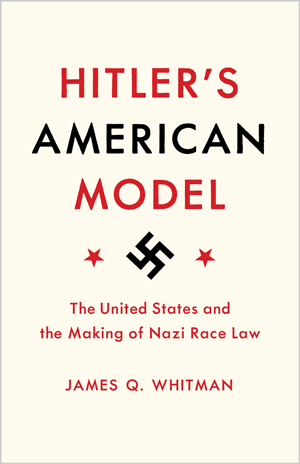Fear of a ‘Black’ President: Obama, Racial Panic and the Presidential Sign
darkmatter: in the ruins of imperial culture
ISSN 2041-3254
Post-Racial Imaginaries [9.1] (2012-07-02)
Cynthia D. Bond, Clinical Professor of Lawyering Skill
The John Marshall Law School, Chicago

I’ve been wonderin’ why
People livin’ in fear
Of my shade
(Or my hi top fade)
I’m not the one that’s runnin’
But they got me on the run
Treat me like I have a gun
All I got is genes and chromosomes.
—Fear of a Black Planet, Public Enemy
I. Introduction
Of all the imaginable racialized backlash, real or representational, to Barack Obama’s candidacy for and inauguration as President of the United States, probably no one would have predicted the relatively widespread depiction of him as Adolf Hitler. Even a cursory knowledge of Hitler’s ‘policies’ as leader of the Third Reich and his eugenicist crimes against humanity would seem to make analogies between he and Obama intellectually incoherent, at a minimum, and otherwise patently outrageous. Nevertheless, this narrative cropped up during the 2008 campaign, where Hitler-Obama comparisons were found on the Internet, even on pro-Hillary Clinton websites (though apparently not sponsored or supported by Clinton herself). After the inauguration, Hitler-Obama comparisons were rife in town hall meetings on the health insurance bill. And they were common in the discourse of Rush Limbaugh, on numerous apparently homegrown websites, and even on relatively benign, apolitical blogs and chat boards like Yahoo! Answers. In 2010, a large billboard posted by the North Iowa Tea Party equating Obama with Hitler (and conflating socialism with both) drew national attention and ire. And in 2011, even the talking heads on Fox & Friends, the Fox News morning show, recoiled when Hank Williams, Jr., compared Obama playing golf with Representative John Boehner to Israeli Prime Minister Benjamin Netanyahu playing with Hitler.
Most thinking people would be inclined to simply dismiss these images and comparisons between Hitler and Obama as absurd fringe lunacy or Photoshop ephemera. And indeed, many of these images are graphically contradictory, evoking inconsistencies even within their own world of signification. Some may find these images offensive to the memory of those who suffered under Hitler, but nonsensical in their relationship to Obama himself. And at first glance, the motives behind these messages may seem to be no more profound than simplistic, politically partisan attempts to malign Obama. Or perhaps they simply represent the playing out of the seemingly inexhaustible Hitler meme.
However, the sheer ubiquity of these types of images and references, indeed the viral nature of them on the Internet and elsewhere, makes them more than a representational blip on the pop cultural radar. In addition, these references extend beyond a few marginal Internet sites to high-profile voices of the Right such as Sarah Palin, Glenn Beck, and others, making them even more disturbing. Finally, these images merit examination because, as Elizabeth Abel suggests, the historic nature of Obama’s election may divert attention from ‘the ways that racial panic and taboo are mediated by the verbal and visual technologies that have always intersected in the construction of race.’
I argue that this phenomenon of the conflation of Obama and Hitler channels racial anxieties, and even outright panic, about a ‘non-white’ president taking office. I situate this panic within ‘whiteness,’ and argue that it encompasses not just the fear of a ‘black’ president, but also the fear of unsettling the purportedly settled categories of race itself. This panic may be muted by the discourse of colorblindness and post-racialism, but finds voice in these ‘hybrid’ significations of Obama.
On a formal level, the internal contradiction and cognitive dissonance of these images is not merely coincidental to the images themselves, but rather reflects the paradoxes and contradictions of an Obama presidency viewed from the position of white racial panic. These contradictions may be read as representational pathologies generated by the perceived plurality or hybridity of racial referents Obama embodies as a bi-racial person. W.J.T. Mitchell suggests that, in the context of Obama as a signifier of bi-racialism, ‘the key to Obama’s iconicity resides not in determinacy but ambiguity, not in identity but differential hybridity.’ And as I will discuss more fully later on, Obama’s position as an apparently ‘black’ man in a historically ‘White House’ also evokes notions of hybridity. Ultimately, these significations attempt to ‘re-other’ Obama now that he has entered the office that most visibly represents the United States as a nation.
In addition, these contradictions in signification may in part result from the difficulties the Right encounters in maintaining its preferred discourse of colorblindness, while simultaneously seeking to stir white racial anxieties to fuel anti-Obama sentiment. Thus, in the Right’s signification of Obama, ‘both the stabilizing project of racial classification and the destabilizing strategies that call that project into question’ are essential to activating, and indeed constituting, white racial panic…
…The suppression of racial signification in the images correlates with the suppression of the central role that virulent racism and xenophobia played in Hitler’s agenda and in the actions of the Third Reich. Thus, there is a kind of ideological ‘whiteface’ in this image; an elision of the way that Hitler’s policies would not even allow for the existence of Obama, much less for a shared political approach.
Yet to say that racial signification is suppressed here is not to say that it is non-existent. In addition to the overdetermined sign of President, Obama’s presidency brings with it the overdetermined meanings of blackness and black maleness. Significantly, Obama’s bi-racialism, in the residual ideology of the ‘one drop’ rule, is read as ‘black’ by most ‘whites.’ As Shawn Michelle Smith suggests, this positionality may have particular resonance in our current historical moment:
Obama is a key transitional figure between the racially divided generation of the Baby Boomers and the future generations that will see the decline of a white majority in the United States through immigration. Perhaps this is why his whiteness seems to matter so much. If, as the son of an immigrant Kenyan man, Obama represents a new kind of blackness, perhaps he also represents a new kind of whiteness—a mixed whiteness to be sure, but for now a whiteness that is tentatively maintaining its hold on an anxious American imagination (or at least its ‘white half’).
Interestingly, Smith’s own analysis here wavers between the narratives of the white/black binary (Obama’s ‘white half’ and ‘black half’), and more fluid notions of hybridity, in which ‘whiteness’ (and ‘blackness’) are remade.
As noted above, Obama’s racial hybridity potentially embodies age-old anxieties about racial ‘mixing’–essentially anxieties about the actual indeterminacy of race as a biological matter. Such anxieties fuel the signification of the imagined boundary that is ‘white/non-white,” which, paradoxically, the Hitler images embody. (Note also the clear binary composition of the image, with its diptych presentation). Under this formula, a white viewer would see the image of Obama, regardless of the colors used in it, as the image of a ‘black’ man, with whiteface techniques only serving to reinforce some viewers’ perceptions of his ‘blackness.’…
Read the entire article here.



